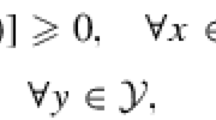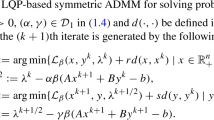Abstract
To solve nonlinear complementarity problems, the inexact logarithmic-quadratic proximal (LQP) method solves a system of nonlinear equations (LQP system) approximately at each iteration. Therefore, the efficiencies of inexact-type LQP methods depend greatly on the involved inexact criteria used to solve the LQP systems. This paper relaxes inexact criteria of existing inexact-type LQP methods and thus makes it easier to solve the LQP system approximately. Based on the approximate solutions of the LQP systems, a descent method, and a prediction–correction method are presented. Convergence of the new methods are proved under mild assumptions. Numerical experiments for solving traffic equilibrium problems demonstrate that the new methods are more efficient than some existing methods and thus verify that the new inexact criterion is attractive in practice.
Similar content being viewed by others
References
Auslender A. and Haddou M. (1995). An interior proximal point method for convex linearly constrained problems and its extension to variational inequalities. Math. Program. 71: 77–100
Auslender A., Teboulle M. and Ben-Tiba S. (1999). A logarithmic-quadratic proximal method for variational inequalities. Comput. Optim. Appl. 12: 31–40
Bauschke H.H. and Combettes P.L. (2001). A weak-to-strong convergence principle for Fejér-monotone methods in Hilbert spaces. Math. Oper. Res. 26(2): 248–264
Burachik R.S. and Iusem A.N. (1998). A generalized proximal point alogrithm for the variational inequality problem in a Hilbert space. SIAM J. Optim. 8: 197–216
Burachik R.S. and Svaiter B.F. (2001). A relative error tolerance for a family of generalized proximal point methods. Math. Oper. Res. 26(4): 816–831
Eaves B.C. (1971). On the basic theorem of complementarity. Math. Program. 1: 68–75
Eckstein J. (1998). Approximating iterations in Bregman-function-based proximal algorithms. Math. Program. 83: 113–123
Güler O. (1991). On the convergence of the proximal point algorithm for convex minimization. SIAM J. Control Optim. 29: 403–419
Han D.R. and He B.S. (2001). A new accuarcy criterion for approximate proximal point algorithms. J. Math. Anal. Appl. 263: 343–353
Harker P.T. and Pang J.S. (1990). Finite-dimensional variational inequality and nonlinear complementarity problems: A survey of theory, algorithms and applications. Math. Program. 48: 161–220
He B.S., Liao L.Z. and Yang Z.H. (2003). A new approximate proximal point algorithm for maximal monotone operator. Sci. China Ser. A 46(2): 200–206
He B.S., Yang Z.H. and Yuan X.M. (2004). An approximate proximal-extragradient type method for monotone variational inequalities. J. Math. Anal. Appl. 300(2): 362–374
He B.S., Liao L.Z. and Yuan X.M. (2006). A LQP method-based interior prediction-correction for nonliner complementarity problems. J. Comput. Math. 24(1): 33–44
He B.S., Xu Y. and Yuan X.M. (2006). A Logarithmic-quadratic proximal prediction-correction method for structured monotone variational inequalities. Comput. Optim. Appl. 35: 19–46
Martinet B. (1970). Regularization d’inéquations variationnelles par approximations succesives. Rev. Fr. Inform. Rech. Opérat. 2: 154–159
Moré J.J. (1996). Global methods for nonlinear complementarity problems. Math. Oper. Res. 21: 589–614
Rockafellar R.T. (1976). Monotone operators and the proximal point algorithm. SIAM J. Optim. 126: 877–898
Teboulle M. (1997). Convergence of proximal-like algorithms. SIAM J. Optim. 7: 1069–1083
Xu, Y., Bnouhachem, A.: A new logarithmic-quadratic proximal prediction–correction method for NCP. manuscript (2006)
Yang H. and Bell M.G.H. (1997). Traffic restraint, road pricing and network equilibrium. Transport. Res. B 31: 303–314
Yuan X.M. (2007). The prediction–correction approach to nonlinear complementarity problems. Eur. J. Oper. Res. 176(3): 1357–1370
Zarantonello E.H. (1971). Projection on covex sets in Hilbert space and sepctral theory. In: Zarantonello, E.H. (eds) Contributation to Nonlinear Functional Analysis, pp 00–00. Academic Press, New York
Author information
Authors and Affiliations
Corresponding author
Rights and permissions
About this article
Cite this article
Yuan, XM. A new criterion for the inexact logarithmic-quadratic proximal method and its derived hybrid methods. J Glob Optim 40, 529–543 (2008). https://doi.org/10.1007/s10898-006-9123-z
Received:
Accepted:
Published:
Issue Date:
DOI: https://doi.org/10.1007/s10898-006-9123-z




